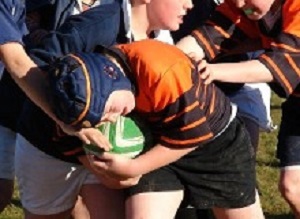For the first time, researchers were able to detect damage to the blood-brain barrier (BBB) caused by mild traumatic brain injury (mTBI), in martial arts fighters and adolescent rugby players, in a small US study.
The researchers studied high-risk populations, specifically professional mixed martial arts (MMA) fighters and adolescent rugby players, to investigate whether the integrity of the blood-brain barrier (BBB) is altered and to develop a technique to better diagnose mild brain trauma.
"While the diagnosis of moderate and severe TBI is visible through magnetic resonance imaging (MRI) and computer-aided tomography scanning (CT), it is far more challenging to diagnose and treat mild traumatic brain injury, especially a concussion which doesn't show up on a normal CT," explains Professor Alon Friedman. Friedman is a ground-breaking neuroscientist and surgeon, who established the Inter-Faculty Brain Sciences School at the American Associates Ben Gurion University of the Negev (BGU).
The study shows that mild impact in professional MMA and adolescent rugby can still lead to a leaky BBB. If in a larger study the results are similar, the brain imaging techniques being developed could be used to monitor athletes to better determine safer guidelines for "return to play."
In this study, MMA fighters were examined pre-fight for a baseline and again within 120 hours following competitive fight. The rugby players were examined pre-season and again post-season or post-match in a subset of cases. Both groups were evaluated using advanced MRI protocol developed at BGU, analysis of BBB biomarkers in the blood and a mouth-guard developed at Stanford University with sensors that track speed, acceleration and force at nearly 10,000 measurements per second.
Ten out of 19 adolescent rugby players showed signs of a leaky blood-brain barrier by the end of the season. Eight rugby players were scanned post-match and two had barrier disruptions. The injuries detected were lower than the current threshold for mild head trauma. The researchers were also able to correlate the level of blood-brain barrier damage seen on an MRI with measurements from the mouthguard sensors.
"The current theory today is that it is the outer surface of the brain that is damaged in a concussion since, during an impact, the brain ricochets off of skull surfaces like Jell-O," Friedman says. "However, we can see now that the trauma's effects are evident much deeper in the brain and that the current model of concussion is too simplistic."
In the next phase of research, the group plans to conduct a similar study in a larger cohort to determine whether BBB disruptions heal on their own and how long that takes. "It is likely that kids are experiencing these injuries during the season but aren't aware of them or are asymptomatic," Friedman says. "We hope our research using MRI and other biomarkers can help better detect a significant brain injury that may occur after what seems to be a 'mild TBI' among amateur and professional athletes."
Abstract
While the diagnosis of moderate and severe TBI is readily visible on current medical imaging paradigms (MRI and CT scanning), a far greater challenge is associated with the diagnosis and subsequent management of mild TBI (mTBI), especially concussion which by definition is characterized by a normal CT. To investigate whether the integrity of the blood-brain barrier (BBB) is altered in a high-risk population for concussions, we studied professional mixed martial arts (MMA) fighters and adolescent rugby players. Additionally, we performed the linear regression between the BBB disruption defined by increased gadolinium contrast extravasation on dynamic contrast-enhanced (DCE-MRI) imaging on MRI and multiple biomechanical parameters indicating the severity of impacts recorded using instrumented mouthguards in professional MMA fighters. MMA fighters were examined pre-fight for a baseline and again within 120 hours post competitive fight, while rugby players were examined pre-season and again post-season or post-match in a sub-set of cases. DCE-MRI, serological analysis of BBB biomarkers, and an analysis of instrumented mouthguard data was performed. Here, we provide pilot data that demonstrates disruption of the BBB in both professional MMA fighters and rugby players, dependent on the level of exposure. Our data suggest that biomechanical forces in professional MMA and adolescent rugby can lead to BBB disruption. These changes on imaging may serve as a biomarker of exposure of the brain to repetitive sub-concussive forces and mTBI.
Authors
Eoin O'Keeffe, Eoin Kelly, Yuzhe Liu, Chiara Giordano, Eugene Wallace, Mark Hynes, Stephen Tiernan, Aidan Meagher, Chris Greene, Stephanie Hughes, Tom Burke, John Kealy, Niamh Doyle, Alison Hay, Michael Farrell, Gerald Grant, Alon Friedman, Ronel Veksler, Michael Molloy, James Meaney, Niall Pender, David Benjamin Camarillo, Colin Doherty, Matthew Campbell
[link url="https://www.sciencedaily.com/releases/2019/09/190925133626.htm"]American Associates Ben Gurion University of the Negev material[/link]
[link url="https://www.liebertpub.com/doi/10.1089/neu.2019.6483"]Journal o Neurotrauma abstract[/link]

